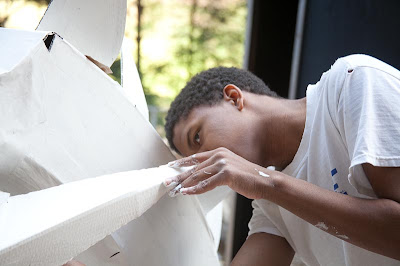This is my last post on this blog that will have to do with assignments from the course, however there will be a few more updates over the next week where I talk about my learning and working with Final Cut Studio Pro and my last visit to Jewish service this Saturday, as well as some information on Jewish Sunday School.
All that being said, if everything goes as planned (IF lol) the final post with my finished videos for the class should be up sometime Wednesday or Thursday of next week.
So, on to the final class assignment.
For this post we had to analyze several more cultural artifacts from the culture we are studying. Jewish culture (at least around here - the good ol' south of the U.S. of A.) doesn't really have any advertising targeted at them, so I decided to look online at some websites targeted to the Jewish community.
Boy, I found some interesting things. When I started looking I was thinking to myself, "Wow, wouldn't it be funny if I found some corny Jewish dating site because all of the regular dating sites are bad enough" and well...well let's just take a look at this very...interesting...spoof on the popular PC vs. Mac commercials
This video is a little over the top in my opinion, but it gets the point across. The kairos is obvious: right now. The video basically tells you to stop waiting and go out and do something (about your being a single Jewish male/female). And, the video is pretty logical about the situation too. You have the one person waiting for prince charming talking about all these ridiculous things (or at least they are portrayed that way) while you have the "voice of reason" talking about how it is so much more logical to go and use this online dating service. This video tries to connect on a personal level by having the girls in the video just like "average" (Jewish) girls and even speaking to (what is seemingly) every girl's dream about having a prince charming come and whisk them away (this hits on the pathos level too) however the logos comes back in here with the girl on the right telling the one on the left that there is no way for Prince Charming to find you if you don't get out there and be active about it.
All in all, a little too over the top for my taste, but a pretty funny video and it covers all the areas of rhetorical analysis very well.
One of the websites that I stumbled on while searching for things for this post is called aish.com. I am not sure what that stands for, but it is called (or calls itself rather) "The Jewish Website" and seems to contain basic information about current events for Jewish people all over the world. This is a look at the top of their page

It is obviously about Israel and Jewish culture and (at the moment) Israel's independence day and Jewish National freedom seem to play a big part in the considerations and links on the home page. Though, as you can see, there at the top there are links to other parts of the site. This is pretty logical and standard for most websites. Following the logic trail, on the right site of the page is a search bar for the site, and a list of links to popular articles on the site. This provides an easy to use (approachable) feeling to the website and makes them appear as more of an equal than an over bearing site.
Here is another simple ad that I found.

The kairos of this ad is "now" (like most ads seem to be lol) and there is a particular pathos with this ad. It is appealing to the Jewish since of family and and the want to please one's mother. (I think that it also might be trying to be a bit sarcastic though I am not sure. To me it seems that way, but my generation is sarcastic about lots of things.)
The last thing that I am going to look at in this post is a rather wordy ad that is more serious in nature.

This is (from the looks of it an old) political ad that actually goes so far as to compare Obama to Islamic Terrorists (cause you know that has never happened before). The kairos is as least recent (though it does seem to call for an immediate action of some sort) however the main thing that this ad is about is the pathos and ethos. The ethos is that of a group of concerned individuals like the reader, yet who also have a more informed stance on things, but are willing and wanting to share this information with the reader. The pathos this is meant to evoke is one of pain, anger, impassioned national pride and ethnic unity, and move the reader to take action.
So, that is is for my class assignments. Stay tuned over the next week as I will be posting updates about my final project.












